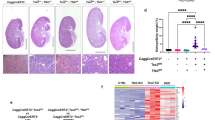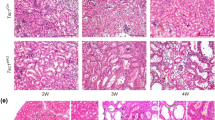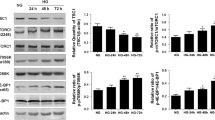Abstract
Functional inactivation of tuberous sclerosis 2 gene (Tsc2) leads to renal carcinogenesis in the hereditary renal carcinoma Eker rat models. Recent studies revealed a role of tuberin, a TSC2 product, in suppressing the p70 S6 kinase (p70S6K) activity via inhibition of mammalian target of rapamycin (mTOR). Phosphorylated S6 protein, a substrate of p70S6K, was expressed in the early lesions in Eker rats, and this expression was suppressed by the treatment of rapamycin, an inhibitor of mTOR. We previously isolated the novel gene Niban expressed in renal carcinogenesis of Eker rats. In this study, we demonstrated that the expression of Niban was detected from early preneoplastic lesions in Eker rats. Interestingly, in contrast to the phosphorylated S6 protein, the expression of Niban was unchanged and early lesions still remained even after treatment with rapamycin. These results might suggest the existence of another pathway independent of mTOR-S6K pathway in Tsc2 mutant renal carcinogenesis. In addition, Niban was also expressed in other renal carcinoma models, including Tsc1 and Tsc2 knockout mice, and various types of human renal cell carcinomas. Thus, Niban was commonly expressed in renal carcinomas and might be a new marker for renal carcinogenesis.
This is a preview of subscription content, access via your institution
Access options
Subscribe to this journal
Receive 50 print issues and online access
$259.00 per year
only $5.18 per issue
Buy this article
- Purchase on Springer Link
- Instant access to full article PDF
Prices may be subject to local taxes which are calculated during checkout





Similar content being viewed by others
References
Dan HC, Sun M, Yang L, Feldman RI, Sui XM, Ou CC, Nellist M, Yeung RS, Halley DJ, Nicosia SV, Pledger WJ and Cheng JQ . (2002). J. Biol. Chem., 277, 35364–35370.
Eker R and Mossige J . (1961). Nature, 189, 858–859.
Gao X and Pan D . (2001). Genes Dev., 15, 1383–1392.
Gao X, Zhang Y, Arrazola P, Hino O, Kobayashi T, Yeung RS, Ru B and Pan D . (2002). Nat. Cell Biol., 4, 699–704.
Hino O, Klein-Szanto AJ, Freed JJ, Testa JR, Brown DQ, Vilensky M, Yeung RS, Tartof KD and Knudson AG . (1993). Proc. Natl. Acad. Sci. USA, 90, 327–331.
Hino O, Kobayashi T, Tsuchiya H, Kikuchi Y, Kobayashi E, Mitani H and Hirayama Y . (1994). Biochem. Biophys. Res. Commun., 203, 1302–1308.
Hino O, Okimoto K, Kouchi M and Sakurai J . (2001). Jpn. J. Cancer Res., 92, 1147–1149.
Hino O, Kobayashi T, Momose S, Kikuchi Y, Adachi H and Okimoto K . (2003). Cancer Sci., 94, 142–147.
Inoki K, Li Y, Zhu T, Wu J and Guan KL . (2002). Nat. Cell Biol., 4, 648–657.
Kenerson HL, Aicher LD, True LD and Yeung RS . (2002). Cancer Res., 62, 5645–5650.
Kobayashi T, Adachi H, Mitani H, Hirayama Y and Hino O . (2003). Proc. Jpn. Acad., 79, 22–25.
Kobayashi T, Hirayama Y, Kobayashi E, Kubo Y and Hino O . (1995). Nat. Genet., 9, 70–74.
Kobayashi T, Minowa O, Kuno J, Mitani H, Hino O and Noda T . (1999). Cancer Res., 59, 1206–1211.
Kobayashi T, Minowa O, Sugitani Y, Takai S, Mitani H, Kobayashi E, Noda T and Hino O . (2001). Proc. Natl. Acad. Sci. USA, 98, 8762–8767.
Kon S, Maeda M, Segawa T, Hagiwara Y, Horikoshi Y, Chikuma S, Tanaka K, Rashid MM, Inobe M, Chambers AF and Uede T . (2000). J. Cell Biochem., 77, 487–498.
Kubo Y, Klimek F, Kikuchi Y, Bannasch P and Hino O . (1995). Cancer Res., 55, 989–990.
Majima S, Kajino K, Fukuda T, Otsuka F and Hino O . (2000). Jpn. J. Cancer Res., 91, 869–874.
Manning BD, Tee AR, Logsdon MN, Blenis J and Cantley LC . (2002). Mol. Cell, 10, 151–162.
Okimoto K, Kouchi M, Kikawa E, Toyosawa K, Koujitani T, Tanaka K, Matsuoka N, Sakurai J and Hino O . (2000). Jpn. J. Cancer Res., 91, 1096–1099.
Potter CJ, Huang H and Xu T . (2001). Cell, 105, 357–368.
Takahashi R, Hirabayashi M, Yanai N, Obinata M and Ueda M . (1999). Exp. Anim., 48, 255–261.
Tapon N, Ito N, Dickson BJ, Treisman JE and Hariharan IK . (2001). Cell, 105, 345–355.
Yeung RS, Xiao GH, Jin F, Lee WC, Testa JR and Knudson AG . (1994). Proc. Natl. Acad. Sci. USA, 91, 11413–11416.
Acknowledgements
We thank Drs K Okimoto (Nihon rats) and R Takahashi (SV40 large T antigen transgenic rats) for making available unpublished data. We also thank Dr I Fukui for supplying human samples. This work is supported in part by Grants-in-Aid for Cancer Research from the Ministry of Education, Culture, Sports and Science Technology of Japan and the Ministry of Health, Labour and Welfare of Japan.
Author information
Authors and Affiliations
Corresponding author
Rights and permissions
About this article
Cite this article
Adachi, H., Majima, S., Kon, S. et al. Niban gene is commonly expressed in the renal tumors: a new candidate marker for renal carcinogenesis. Oncogene 23, 3495–3500 (2004). https://doi.org/10.1038/sj.onc.1207468
Received:
Revised:
Accepted:
Published:
Issue Date:
DOI: https://doi.org/10.1038/sj.onc.1207468
Keywords
This article is cited by
-
Alterations in niban gene expression as a response to stress conditions in 3T3-L1 adipocytes
Molecular Biology Reports (2020)
-
miR-4521-FAM129A axial regulation on ccRCC progression through TIMP-1/MMP2/MMP9 and MDM2/p53/Bcl2/Bax pathways
Cell Death Discovery (2019)
-
Regulation of the unfolded protein response through ATF4 and FAM129A in prostate cancer
Oncogene (2019)
-
miR-135a deficiency inhibits the AR42J cells damage in cerulein-induced acute pancreatitis through targeting FAM129A
Pflügers Archiv - European Journal of Physiology (2019)
-
P2X7R antagonism after subfailure overstretch injury of blood vessels reverses vasomotor dysfunction and prevents apoptosis
Purinergic Signalling (2017)



